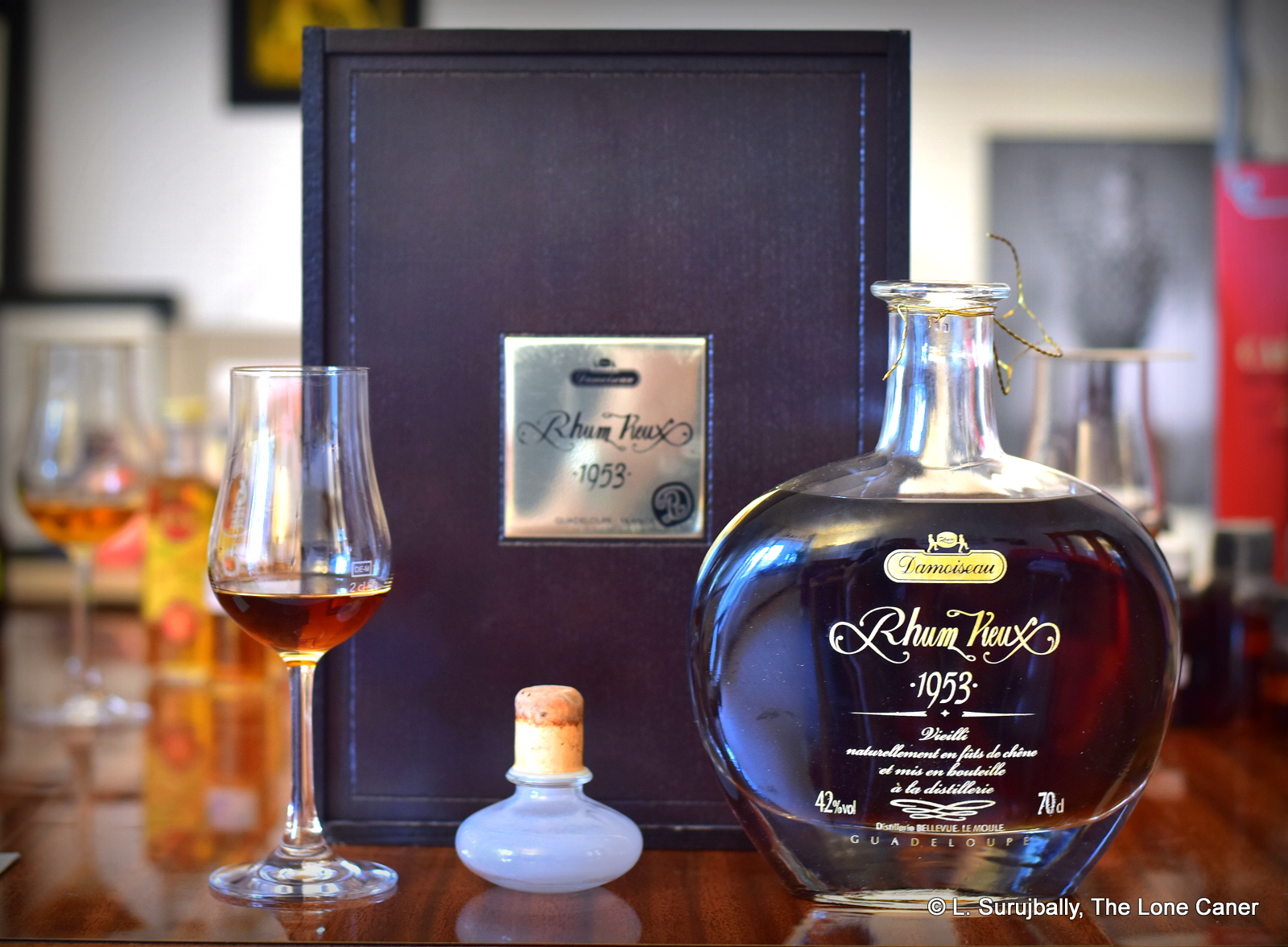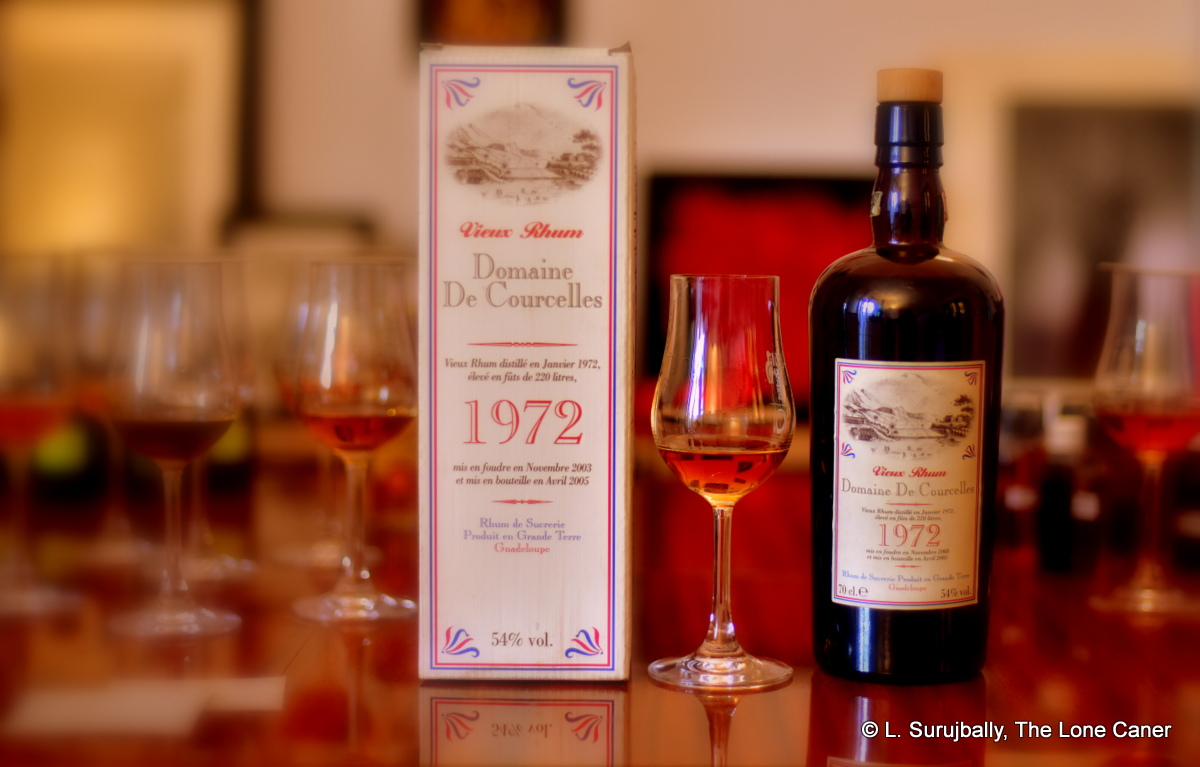
Isla del Ron is one of the smaller independent rum labels out of Europe, such as have sprung up with greater frequency over the last decade. It’s a division of its parent company Unique Liquids, founded around 2009, and located in north central Germany, between Dortmund and Hanover. To add to the complexity, it owns the related company Malts of Scotland – not entirely a surprise, since Thomas Ewers, the founder, likes his whisky perhaps more than rum. Since 2012, the company has produced about 22 various single barrel rums from all the usual suspects around the Caribbean and Central America.
The rhum we’re looking at today is a peculiar specimen: a single cask release of 169 bottles at 52.6%….but where from? Consider the label, which says “South Pacific”. Can you honestly make sense of that, given that even the geographically challenged are aware (we can hope) that Guadeloupe isn’t an island in the Pacific? Alex over at Master Quill explains what’s happening here: Ewers bought a cask marked “South Pacific”, but which had been mislabelled, and was actually from Bellevue…though it’s unclear how he came to that conclusion. Assuming he’s right, that sounds simple enough except…which one? Because there are two Bellevues, one on the small island of Marie-Galante, the other on Guadeloupe (Grand Terre) itself, Damoiseau’s Bellevue at le Moule (That Boutique-y Rum Company made a similar mistake on the label of its Bellevue rhum a couple of years ago).
But it seems to be an unknown: Thomas felt it was from Marie-Galante, and Alex wasn’t so sure, given the variety of 1998 distillate marked Guadeloupe that other indies have released in the past, but which was from Damoiseau’s Bellevue on G-T, not Bellevue on M-G. What this means is that we don’t actually know whether it’s a cane juice rhum or a molasses rum (Damoiseau has a long history of working with both), or for sure which distillery produced it.
But let’s see if the tasting helps us figure things out, because the fact is that the Isla del Ron Guadeloupe is actually a quiet kind of delicious (with certain caveats, which I’ll get to later). The nose, for example, is a warm and soft caramel ice cream pillow with a bunch of contrasting fruity notes (grapes, pomegranates, kiwi fruit) lending it some edge. Bags of toffee, bonbons, flowers and a flirt of licorice waft around the glass, set off with oversweet strawberry bubble gum and (peculiarly) some a creamy feta cheese minus the salt. Throughout it remains a pleasant sniff, with some citrus and tannic notes bringing up the rear.
 The nose doesn’t help narrow down the origin (though I have my suspicions), and the palate doesn’t either – but it is nice. It remains light, slightly briny, and just tart enough to be crisp. It has moments of sprightliness and sparkling freshness, tasting of red grapefruit, grapes, sprite, orange zest and herbs (rosemary and dill) – but also presents a contrasting whiff of sharper and slightly bitter oaky aspects, cinnamon, licorice, molasses, with back-end nougat and coconut shavings allowing it to smoothen out somewhat…if not completely successfully, in my view. I do like the finish, which is medium long, medium warm, and quite tasty: closing notes of citrus peel, caramel, pencil shavings and some raisins, plus a few delicate flowers.
The nose doesn’t help narrow down the origin (though I have my suspicions), and the palate doesn’t either – but it is nice. It remains light, slightly briny, and just tart enough to be crisp. It has moments of sprightliness and sparkling freshness, tasting of red grapefruit, grapes, sprite, orange zest and herbs (rosemary and dill) – but also presents a contrasting whiff of sharper and slightly bitter oaky aspects, cinnamon, licorice, molasses, with back-end nougat and coconut shavings allowing it to smoothen out somewhat…if not completely successfully, in my view. I do like the finish, which is medium long, medium warm, and quite tasty: closing notes of citrus peel, caramel, pencil shavings and some raisins, plus a few delicate flowers.
Personally, my opinion on its source tends more towards Damoiseau, what with that distillery releasing rather more bulk rum to brokers than Bellevue, which is smaller and has more of a local market; and the molasses and vanilla and caramel notes point in that direction also. To be honest, though, I thought that the rum’s overall profile fell somewhere in between the crispness of the Bielle 2001 14 YO and a Cuban like Cadenhead’s ADC Spiritu Sancti 1998 14 YO. That’s not a major issue though, because as with most such situations, it’s all about whether it works as a rum or not, and if so, how good it is.
On that basis, I’d say that yes, overall it’s a solid Guadeloupe rhum…just one without real originality. It lacks distinctiveness, and carves out no new territory of its own. It’s a lovely tasting rhum, yes, but unfortunately, also not one you’d be able to remember clearly next week. In that sense, it’s like many bally-hooed and overhyped rums we keep hearing about every day on social media, but which then drop out of sight forever without ever having stirred the emotions of us drinkers in any serious way. And that’s a bit of a shame, really, for a rum that is otherwise quite good.
(#815)(86/100)

 Take this one, which proves that TBRC has a knack for ferreting out good barrels. It’s not often you find a rum that is from the French West Indies aged beyond ten years — Neisson’s been making a splash recently with its 18 YO, you might recall, for that precise reason. To find one that’s a year older from Guadeloupe in the same year is quite a prize and I’ll just mention it’s 54.2%, aged seven years in Guadeloupe and a further twelve in the UK, and outturn is 413 bottles. On stats alone it’s the sort of thing that makes my glass twitch.
Take this one, which proves that TBRC has a knack for ferreting out good barrels. It’s not often you find a rum that is from the French West Indies aged beyond ten years — Neisson’s been making a splash recently with its 18 YO, you might recall, for that precise reason. To find one that’s a year older from Guadeloupe in the same year is quite a prize and I’ll just mention it’s 54.2%, aged seven years in Guadeloupe and a further twelve in the UK, and outturn is 413 bottles. On stats alone it’s the sort of thing that makes my glass twitch. Guadeloupe rums in general lack something of the fierce and stern AOC specificity that so distinguishes Martinique, but they’re close in quality in their own way, they’re always good, and frankly, there’s something about the relative voluptuousness of a Guadeloupe rhum that I’ve always liked. Peter sold me on the quality of the
Guadeloupe rums in general lack something of the fierce and stern AOC specificity that so distinguishes Martinique, but they’re close in quality in their own way, they’re always good, and frankly, there’s something about the relative voluptuousness of a Guadeloupe rhum that I’ve always liked. Peter sold me on the quality of the 










 grassy elements in the background, serving to swell a note or two without ever dominating the symphony
grassy elements in the background, serving to swell a note or two without ever dominating the symphony

